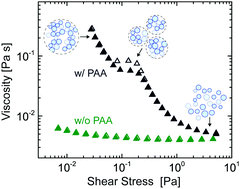Simple production of cellulose nanofibril microcapsules and the rheology of their suspensions
Abstract
Microcapsules are commonly used in applications ranging from therapeutics to personal care products due to their ability to deliver encapsulated species through their porous shells. Here, we demonstrate a simple and scalable approach to fabricate microcapsules with porous shells by interfacial complexation of cellulose nanofibrils and oleylamine, and investigate the rheological properties of suspensions of the resulting microcapsules. The suspensions of neat capsules are viscous liquids whose viscosity increases with volume fraction according to a modified Kreiger–Dougherty relation with a maximum packing fraction of 0.74 and an intrinsic viscosity of 4.1. When polyacrylic acid (PAA) is added to the internal phase of the microcapsules, however, the suspensions become elastic and display yield stresses with power-law dependencies on capsule volume fraction and PAA concentration. The elasticity appears to originate from associative microcapsule interactions induced by PAA that is contained within and incorporated into the microcapsule shell. These results demonstrate that it is possible to tune the rheological properties of microcapsule suspensions by changing only the composition of the internal phase, thereby providing a novel method to tailor complex fluid rheology.



 Please wait while we load your content...
Please wait while we load your content...
